Mars Rover Penetrating Radar Modeling and Interpretation Considering Linear Frequency Modulation Source and Tilted Antenna
Abstract
:1. Introduction
- (1)
- An LFMCW signal is applied to GPR forward modeling and some side lobes appear behind the main lobe after impulse compression. The assessment of the modeling approach is conducted through comparison with RoPeR data. The strong background noise appears both in synthetics and real data, which may be caused by impulse compression and antenna reflections.
- (2)
- A tilted monopole antenna equipped on RoPeR is investigated by considering the antenna structure and tilted angle as well as the rover body. The modeled radargram image exhibits asymmetric hyperbolas, which is further confirmed by real observed data from the laboratory and RoPeR. The tilted antennas’ impact on back-propagation (BP) images is explored, leading to the proposal of the radiation-pattern-compensation BP (RPC-BP) method.
2. Methodology
2.1. Linear Frequency Modulation Montinuous Wave
2.2. Tilted Monopole Antenna
3. Forward Modeling
3.1. Modeling Based on Ricker Wavelet and LFMCW Source
3.2. Modeling Based on Horizontal and Tilted Antennas
3.3. Mars Rover Influence on Recorded Data
3.4. Complex Subsurface Structure Modeling
4. Analysis of Laboratory and Mars Rover Data
4.1. Laboratory Data Analysis
4.2. Mars Rover Data Analysis
5. Discussion
6. Conclusions
Author Contributions
Funding
Data Availability Statement
Acknowledgments
Conflicts of Interest
References
- Ernst, J.R.; Maurer, H.; Green, A.G.; Holliger, K. Full-waveform inversion of crosshole radar data based on 2-d finite-difference time-domain solutions of maxwell’s equations. IEEE Trans. Geosci. Remote Sens. 2007, 45, 2807–2828. [Google Scholar] [CrossRef]
- Ellefsen, K.J.; Mazzella, A.T.; Horton, R.J.; McKenna, J.R. Phase and amplitude inversion of crosswell radar data. Geophysics 2011, 76, J1–J12. [Google Scholar] [CrossRef]
- Zhong, S.; Wang, Y.; Zheng, Y. Frequency-domain wavefield reconstruction inversion of ground-penetrating radar based on sensitivity analysis. Geophys. Prospect. 2023. [Google Scholar] [CrossRef]
- Meles, G.A.; Van Der Kruk, J.; Greenhalgh, S.A.; Ernst, J.R.; Maurer, H.; Green, A.G. A new vector waveform inversion algorithm for simultaneous updating of conductivity and permittivity parameters from combination Crosshole/Borehole-to-surface GPR data. IEEE Trans. Geosci. Remote Sens. 2010, 48, 3391–3407. [Google Scholar] [CrossRef]
- Lavoué, F.; Brossier, R.; Métivier, L.; Garambois, S.; Virieux, J. Two-dimensional permittivity and conductivity imaging by full waveform inversion of multioffset GPR data: A frequency-domain quasi-Newton approach. Geophys. J. Int. 2014, 197, 248–268. [Google Scholar] [CrossRef] [Green Version]
- Zhong, S.; Wang, Y.; Zheng, Y.; Chang, X. Reverse time migration of ground-penetrating radar with full wavefield decomposition based on the Hilbert transform. Geophys. Prospect. 2020, 68, 1097–1112. [Google Scholar] [CrossRef]
- Fang, G.Y.; Zhou, B.; Ji, Y.C.; Zhang, Q.Y.; Shen, S.X.; Li, Y.X. Lunar Penetrating Radar onboard the Chang’e-3 mission. Res. Astron. Astrophys. 2014, 14, 1607–1622. [Google Scholar] [CrossRef]
- Fa, W.; Zhu, M.H.; Liu, T.; Plescia, J.B. Regolith stratigraphy at the Chang’E-3 landing site as seen by lunar penetrating radar. Geophys. Res. Lett. 2015, 42, 10179–10187. [Google Scholar] [CrossRef]
- Li, C.; Su, Y.; Pettinelli, E.; Xing, S.; Ding, C.; Liu, J.; Ren, X.; Lauro, S.E.; Soldovieri, F.; Zeng, X.; et al. The Moon’s farside shallow subsurface structure unveiled by Chang’E-4 Lunar Penetrating Radar. Sci. Adv. 2020, 6, eaay6898. [Google Scholar] [CrossRef] [Green Version]
- Zhang, J.; Zhou, B.; Lin, Y.; Zhu, M.H.; Song, H.; Dong, Z.; Gao, Y.; Di, K.; Yang, W.; Lin, H.; et al. Lunar regolith and substructure at Chang’E-4 landing site in South Pole–Aitken basin. Nat. Astron. 2021, 5, 25–30. [Google Scholar] [CrossRef]
- Hamran, S.E.; Paige, D.A.; Amundsen, H.E.; Berger, T.; Brovoll, S.; Carter, L.; Damsgård, L.; Dypvik, H.; Eide, J.; Eide, S.; et al. Radar Imager for Mars’ Subsurface Experiment—RIMFAX. Space Sci. Rev. 2020, 216, 128. [Google Scholar] [CrossRef]
- Zhou, B.; Shen, S.X.; Lu, W.; Liu, Q.; Tang, C.J.; Li, S.D.; Fang, G.Y. The Mars rover subsurface penetrating radar onboard China’s Mars 2020 mission. Earth Planet. Phys. 2020, 4, 345–354. [Google Scholar] [CrossRef]
- Li, C.; Zheng, Y.; Wang, X.; Zhang, J.; Wang, Y.; Chen, L.; Zhang, L.; Zhao, P.; Liu, Y.; Lv, W.; et al. Layered subsurface in Utopia Basin of Mars revealed by Zhurong rover radar. Nature 2022, 610, 308–312. [Google Scholar] [CrossRef] [PubMed]
- Wang, Y.; Feng, X.; Zhou, H.; Dong, Z.; Liang, W.; Xue, C.; Li, X. Water ice detection research in utopia planitia based on simulation of mars rover full-polarimetric subsurface penetrating radar. Remote Sens. 2021, 13, 2685. [Google Scholar] [CrossRef]
- Ciarletti, V.; Corbel, C.; Plettemeier, D.; Caïs, P.; Clifford, S.M.; Hamran, S.E. WISDOM GPR Designed for shallow and high-resolution sounding of the martian subsurface. Proc. IEEE 2011, 99, 824–836. [Google Scholar] [CrossRef]
- Jol, H.M. Ground Penetrating Radar Theory and Applications; Elsevier: Amsterdam, The Netherlands, 2009. [Google Scholar] [CrossRef]
- Lee, J.S.; Nguyen, C.; Scullion, T. A novel, compact, low-cost, impulse ground-penetrating radar for nondestructive evaluation of pavements. IEEE Trans. Instrum. Meas. 2004, 53, 1502–1509. [Google Scholar] [CrossRef]
- Eide, S.; Casademont, T.; Aardal, Ø.L.; Hamran, S.e. Modeling FMCW Radar for Subsurface Analysis. IEEE J. Sel. Top. Appl. Earth Obs. Remote Sens. 2022, 15, 2998–3007. [Google Scholar] [CrossRef]
- Stickley, G.F.; Noon, D.A.; Cherniakov, M.; Longstaff, I.D. Gated stepped-frequency ground penetrating radar. J. Appl. Geophys. 2000, 43, 259–269. [Google Scholar] [CrossRef]
- Fauchard, C.; Côte, P.; Le Brusq, E.; Guillanton, E.; Dauvignac, J.Y.; Pichot, C. Step-frequency radar applied on thin road layers. J. Appl. Geophys. 2001, 47, 317–325. [Google Scholar] [CrossRef]
- Irving, J.; Knight, R. Numerical modeling of ground-penetrating radar in 2-D using MATLAB. Comput. Geosci. 2006, 32, 1247–1258. [Google Scholar] [CrossRef]
- Hilton, G.S.; Railton, C.J.; Ball, G.J.; Hume, A.L.; Dean, M. Finite-difference time-domain analysis of a printed dipole antenna. IEE Conf. Publ. 1995, 1, 72–75. [Google Scholar] [CrossRef]
- Giannakis, I.; Giannopoulos, A.; Warren, C. Realistic FDTD GPR Antenna Models Optimized Using a Novel Linear/Nonlinear Full-Waveform Inversion. IEEE Trans. Geosci. Remote Sens. 2019, 57, 1768–1778. [Google Scholar] [CrossRef]
- Lee, K.H.; Chen, C.C.; Teixeira, F.L.; Lee, R. Modeling and investigation of a geometrically complex UWB GPR antenna using FDTD. IEEE Trans. Antennas Propag. 2004, 52, 1983–1991. [Google Scholar] [CrossRef]
- Warren, C.; Giannopoulos, A. Creating finite-difference time-domain models of commercial ground-penetrating radar antennas using Taguchi’s optimization method. Geophysics 2011, 76, G37–G47. [Google Scholar] [CrossRef]
- Hamran, S.E.; Gjessing, D.T.; Hjelmstad, J.; Aarholt, E. Ground penetrating synthetic pulse radar: Dynamic range and modes of operation. J. Appl. Geophys. 1995, 33, 7–14. [Google Scholar] [CrossRef]
- Hamran, S.E. Radar Performance of Ultra Wideband Waveforms. Radar Technol. 2010, 410. [Google Scholar] [CrossRef] [Green Version]
- Tian, H.; Zhang, T.; Jia, Y.; Peng, S.; Yan, C. Zhurong: Features and mission of China’s first Mars rover. Innovation 2021, 2, 100121. [Google Scholar] [CrossRef]
- Zhang, L.; Xu, Y.; Liu, R.; Chen, R.; Bugiolacchi, R.; Guo., R. The Dielectric Properties of Martian Regolith at the Tianwen-1 Landing Site. Geophys. Res. Lett. 2023, 50, e2022GL102207. [Google Scholar] [CrossRef]
- Warren, C.; Giannopoulos, A.; Giannakis, I. gprMax: Open source software to simulate electromagnetic wave propagation for Ground Penetrating Radar. Comput. Phys. Commun. 2016, 209, 163–170. [Google Scholar] [CrossRef] [Green Version]
- Warren, C.; Giannopoulos, A.; Gray, A.; Giannakis, I.; Patterson, A.; Wetter, L.; Hamrah, A. A CUDA-based GPU engine for gprMax: Open source FDTD electromagnetic simulation software. Comput. Phys. Commun. 2019, 237, 208–218. [Google Scholar] [CrossRef]
- Li, C.; Xing, S.; Lauro, S.E.; Su, Y.; Dai, S.; Feng, J.; Cosciotti, B.; Di Paolo, F.; Mattei, E.; Xiao, Y.; et al. Pitfalls in GPR Data Interpretation: False Reflectors Detected in Lunar Radar Cross Sections by Chang’e-3. IEEE Trans. Geosci. Remote Sens. 2018, 56, 1325–1335. [Google Scholar] [CrossRef]
- Angelopoulos, M.; Redman, D.; Pollard, W.H.; Haltigin, T.W.; Dietrich, P. Lunar ground penetrating radar: Minimizing potential data artifacts caused by signal interaction with a rover body. Adv. Space Res. 2014, 54, 2059–2072. [Google Scholar] [CrossRef]
- Radzevicius, S.J.; Guy, E.D.; Daniels, J.J. Pitfalls in GPR data interpretation: Differentiating stratigraphy and buried objects from periodic antenna and target effects. Geophys. Res. Lett. 2000, 27, 3393–3396. [Google Scholar] [CrossRef] [Green Version]
- Tan, X.; Liu, J.; Zhang, X.; Yan, W.; Chen, W.; Ren, X.; Zuo, W.; Li, C. Design and Validation of the Scientific Data Products for China’s Tianwen-1 Mission. Space Sci. Rev. 2021, 217, 69. [Google Scholar] [CrossRef]
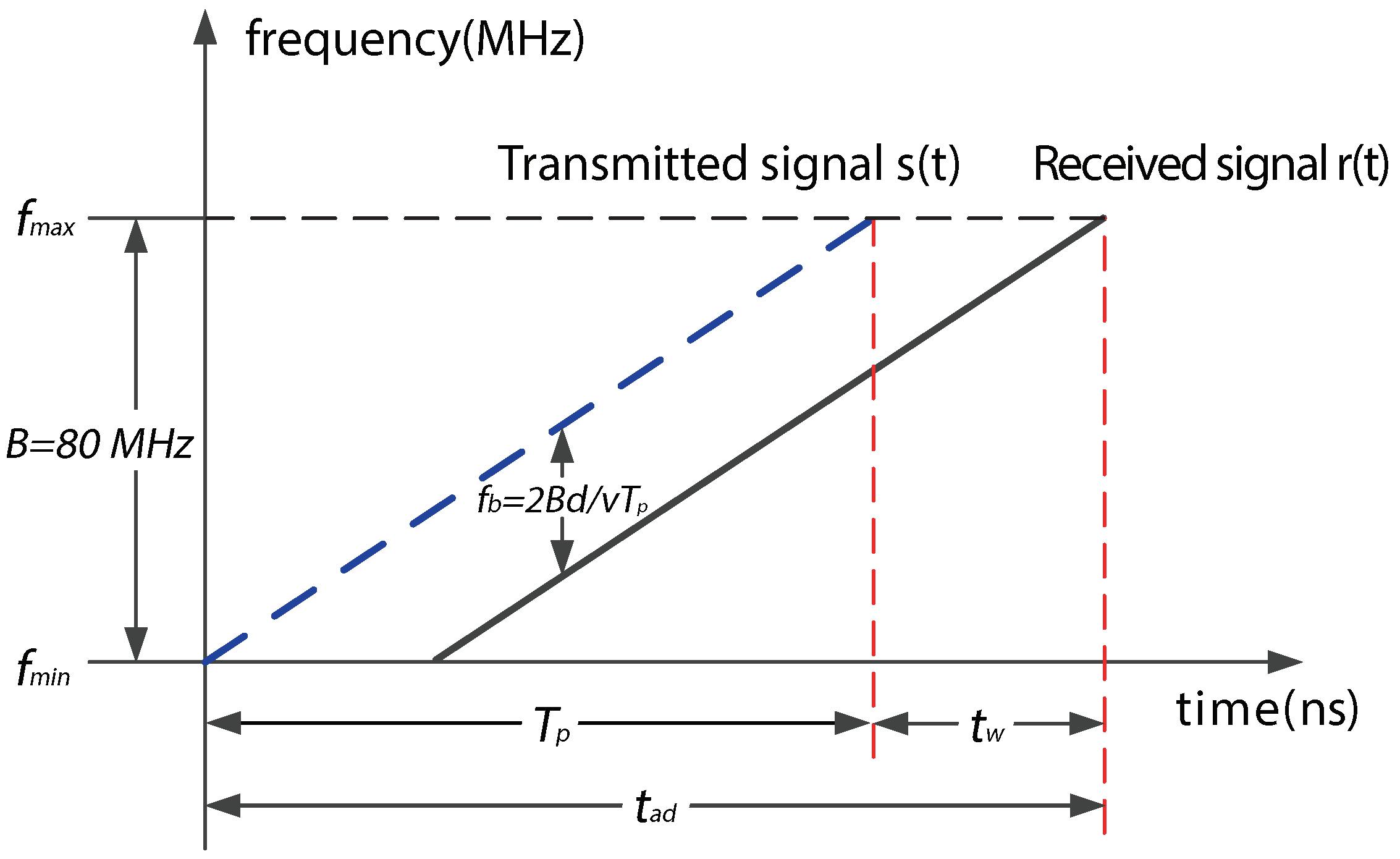
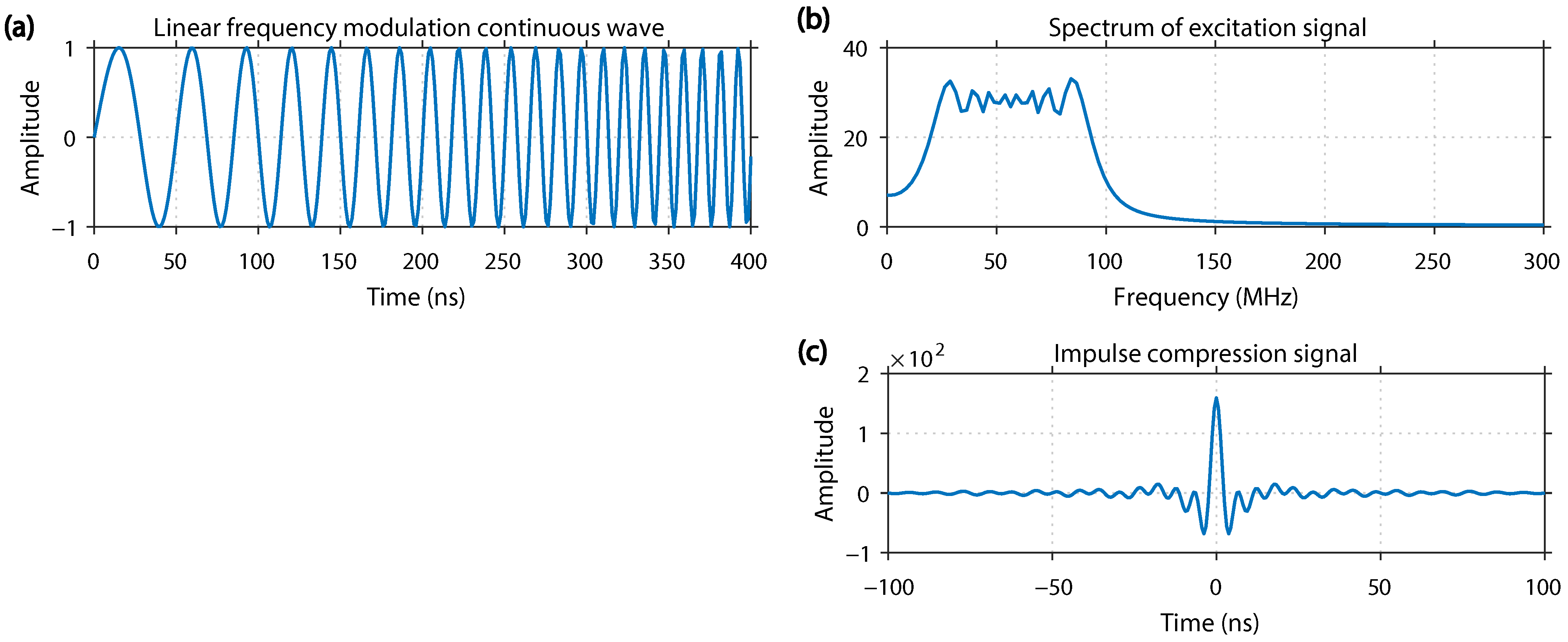
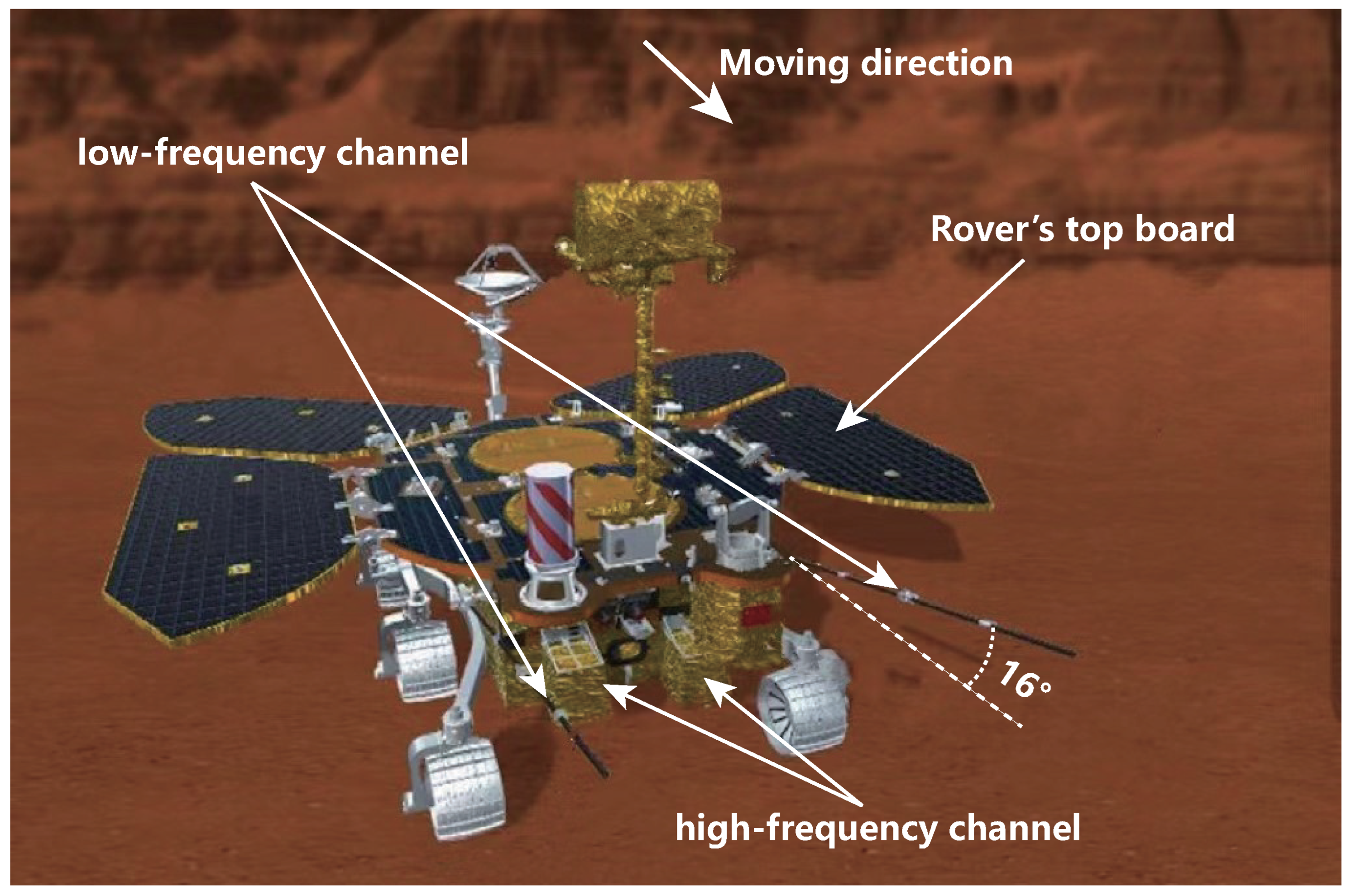


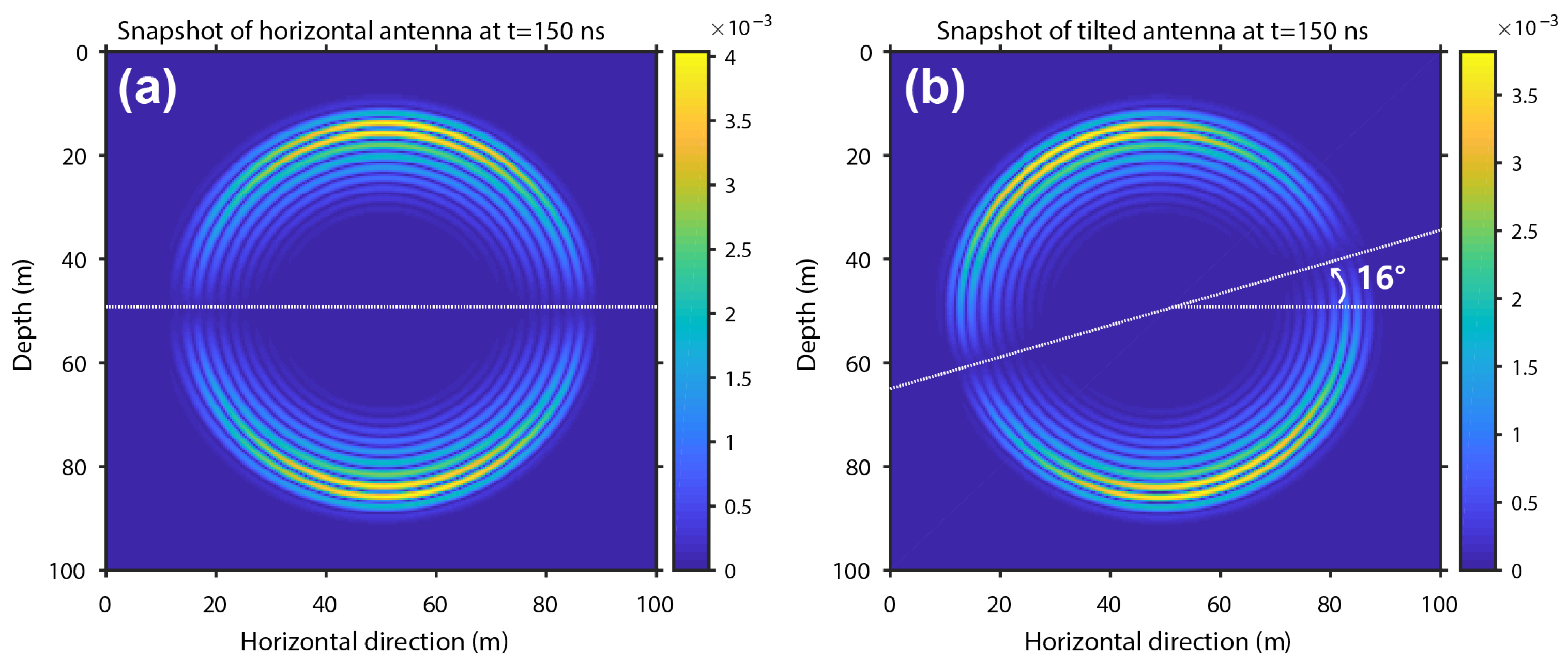

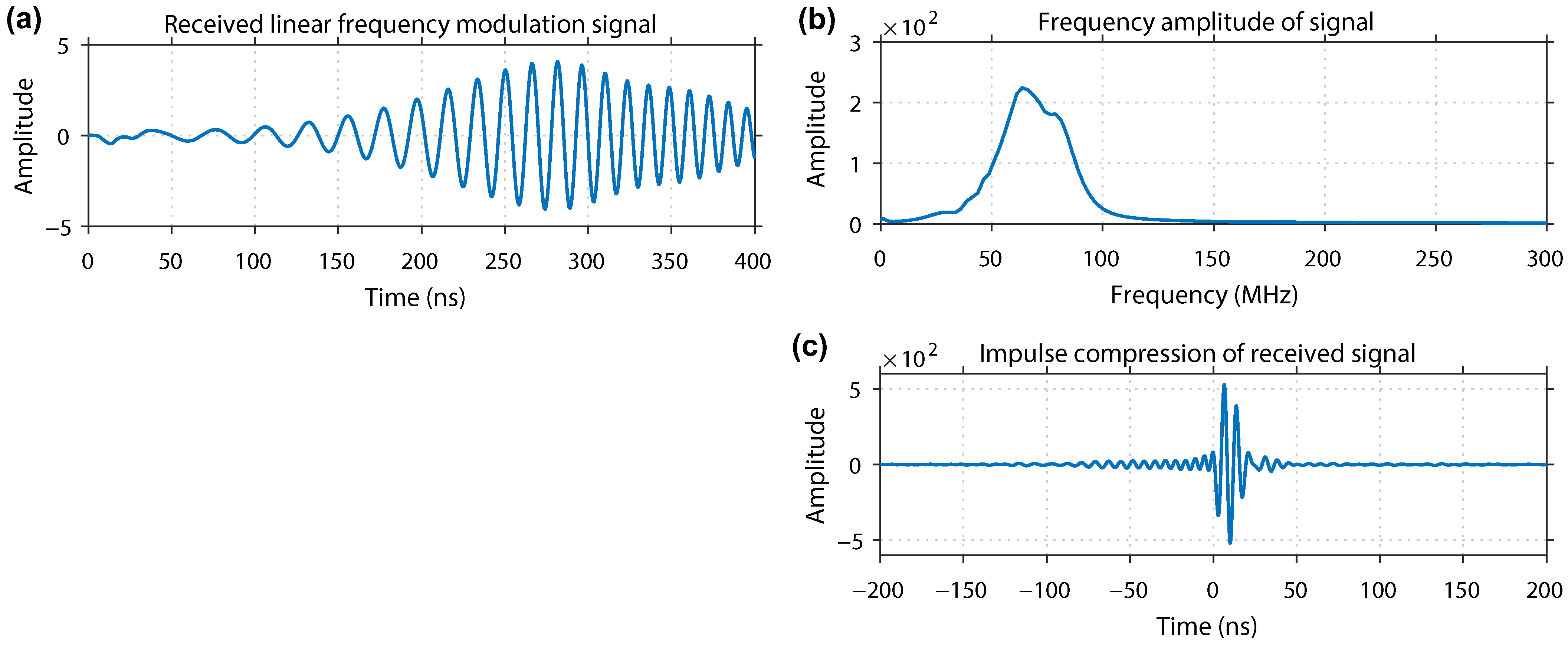
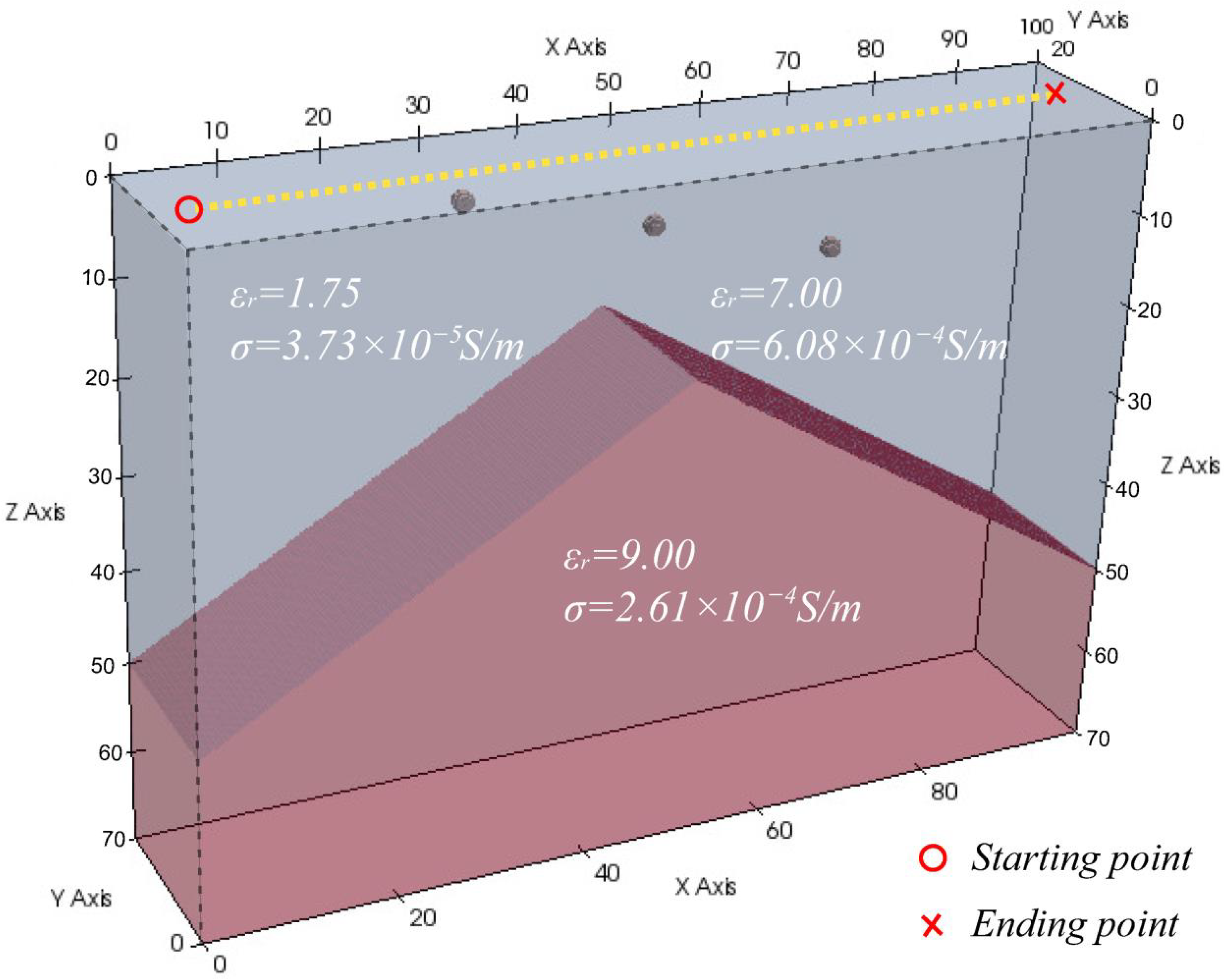

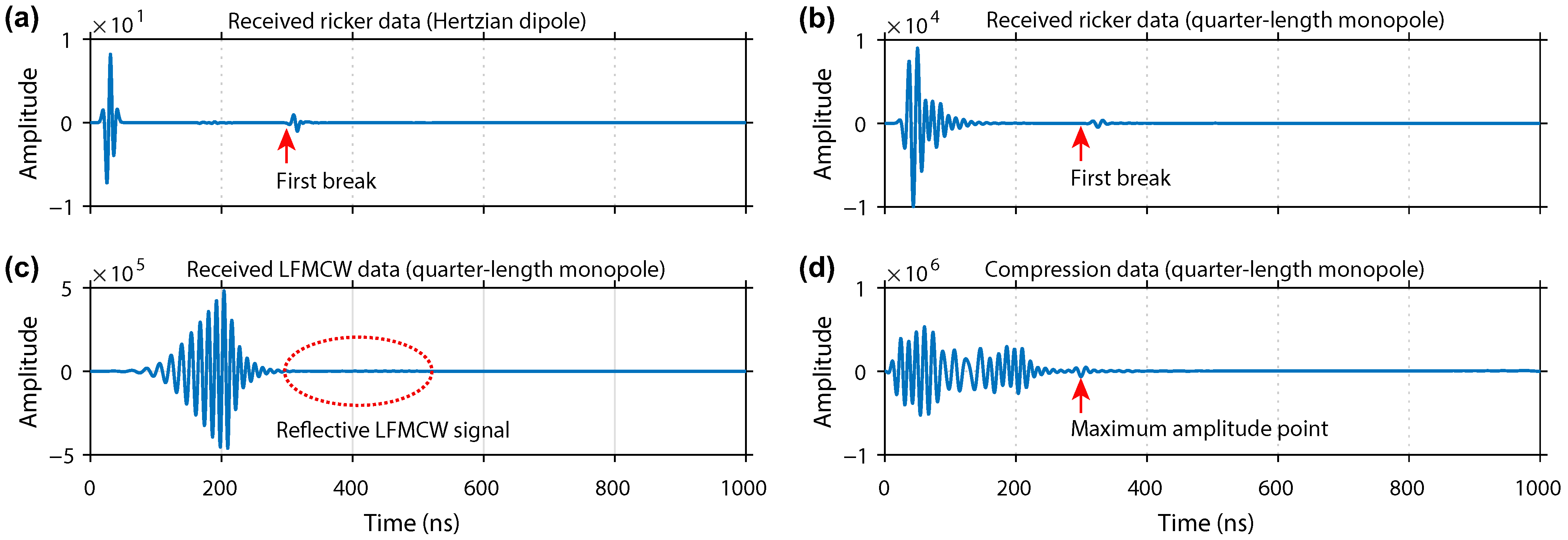


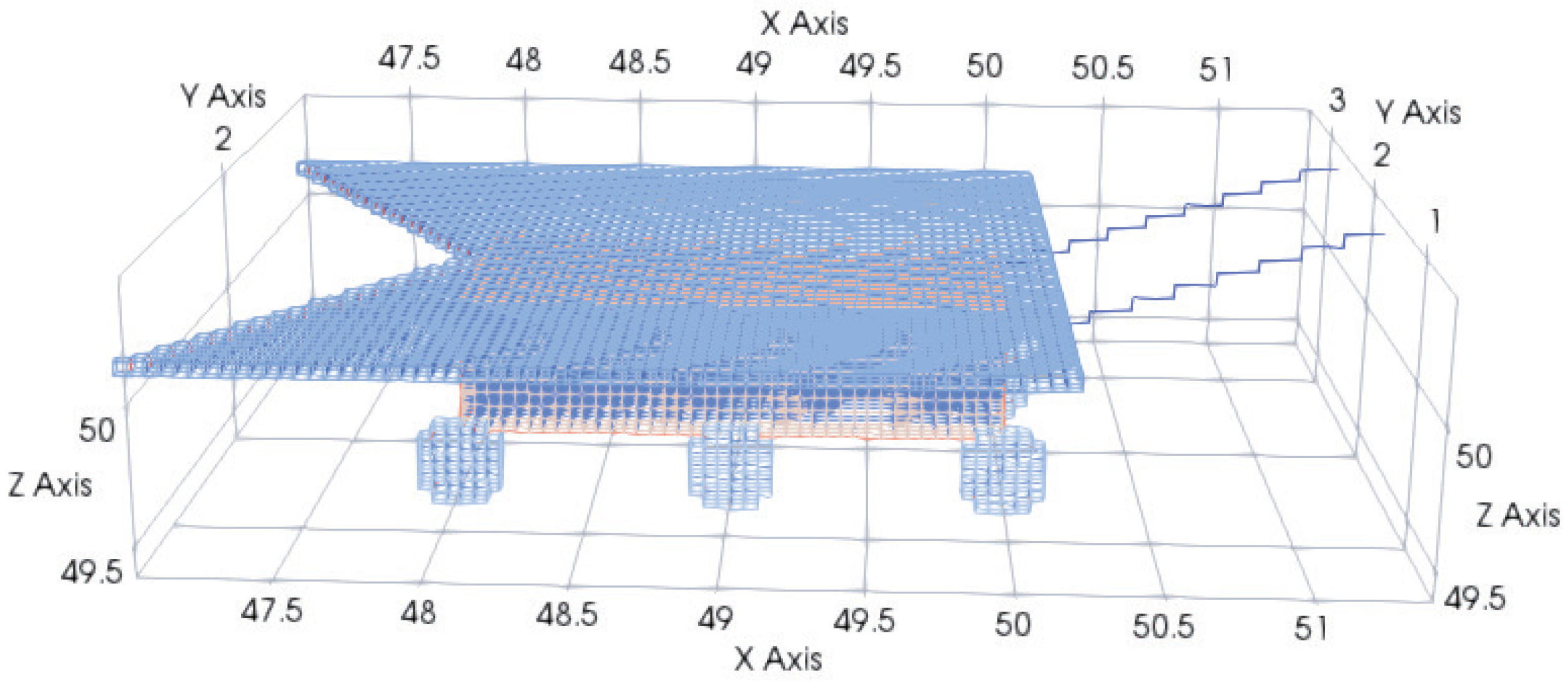


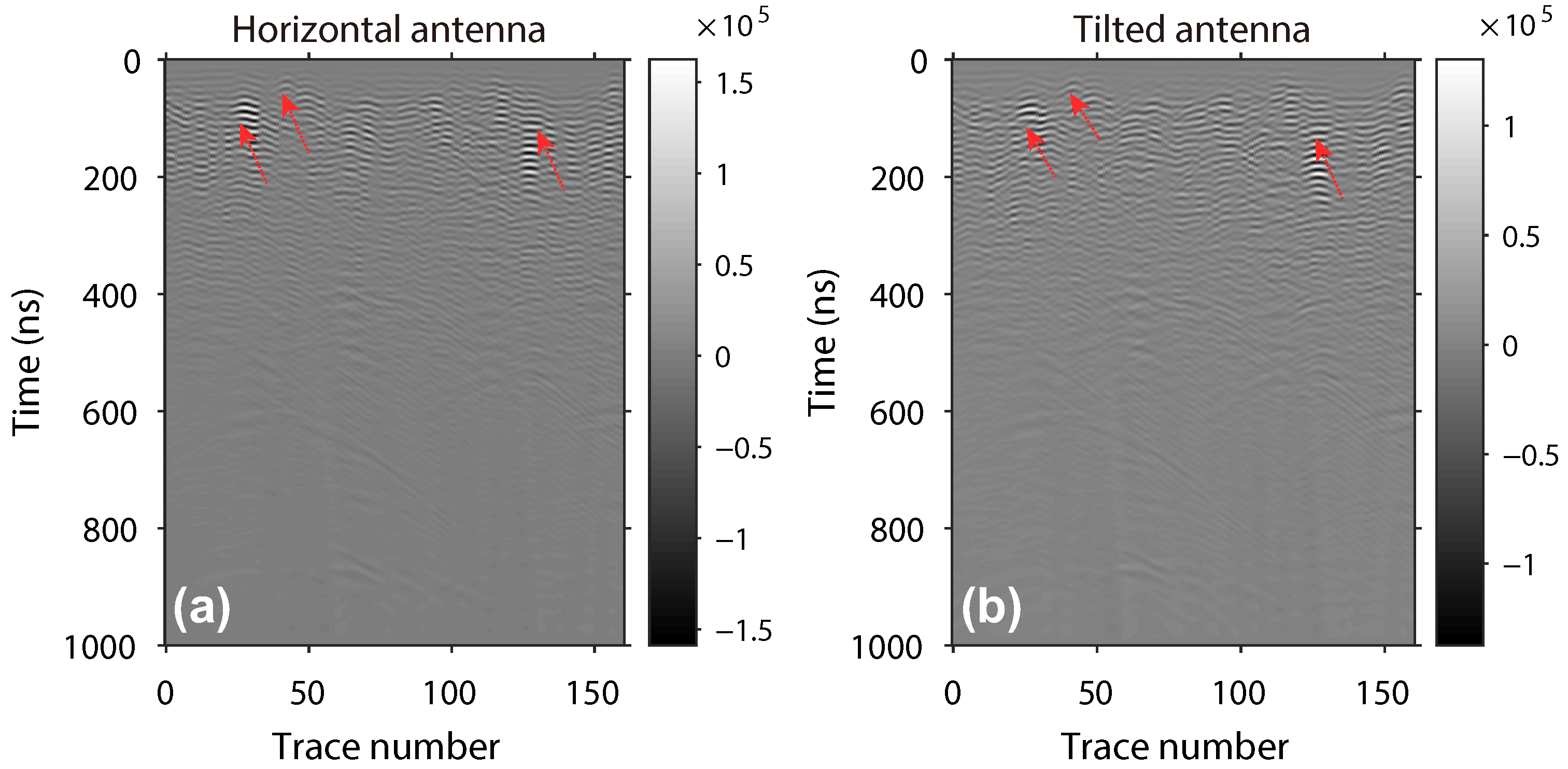


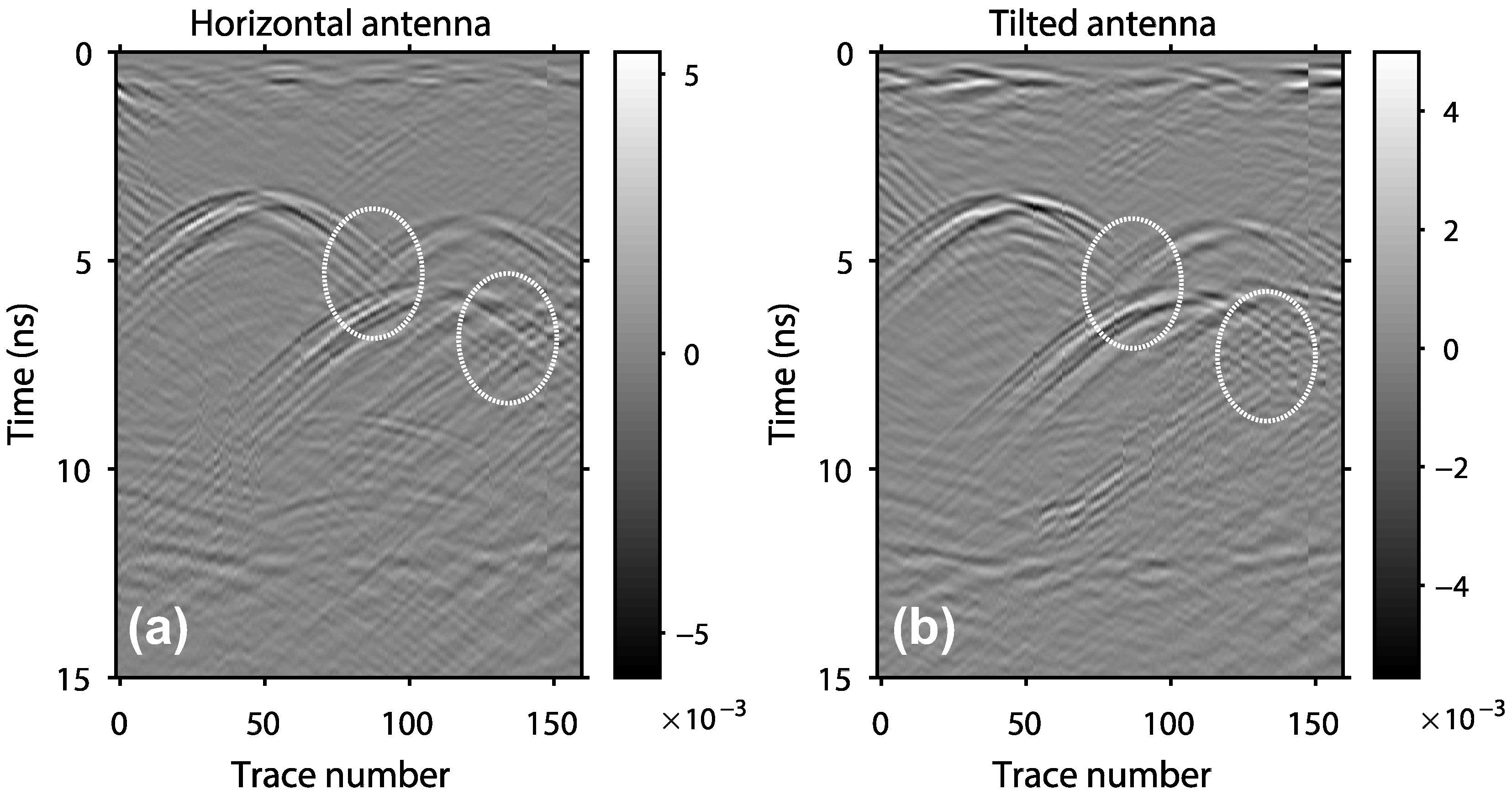
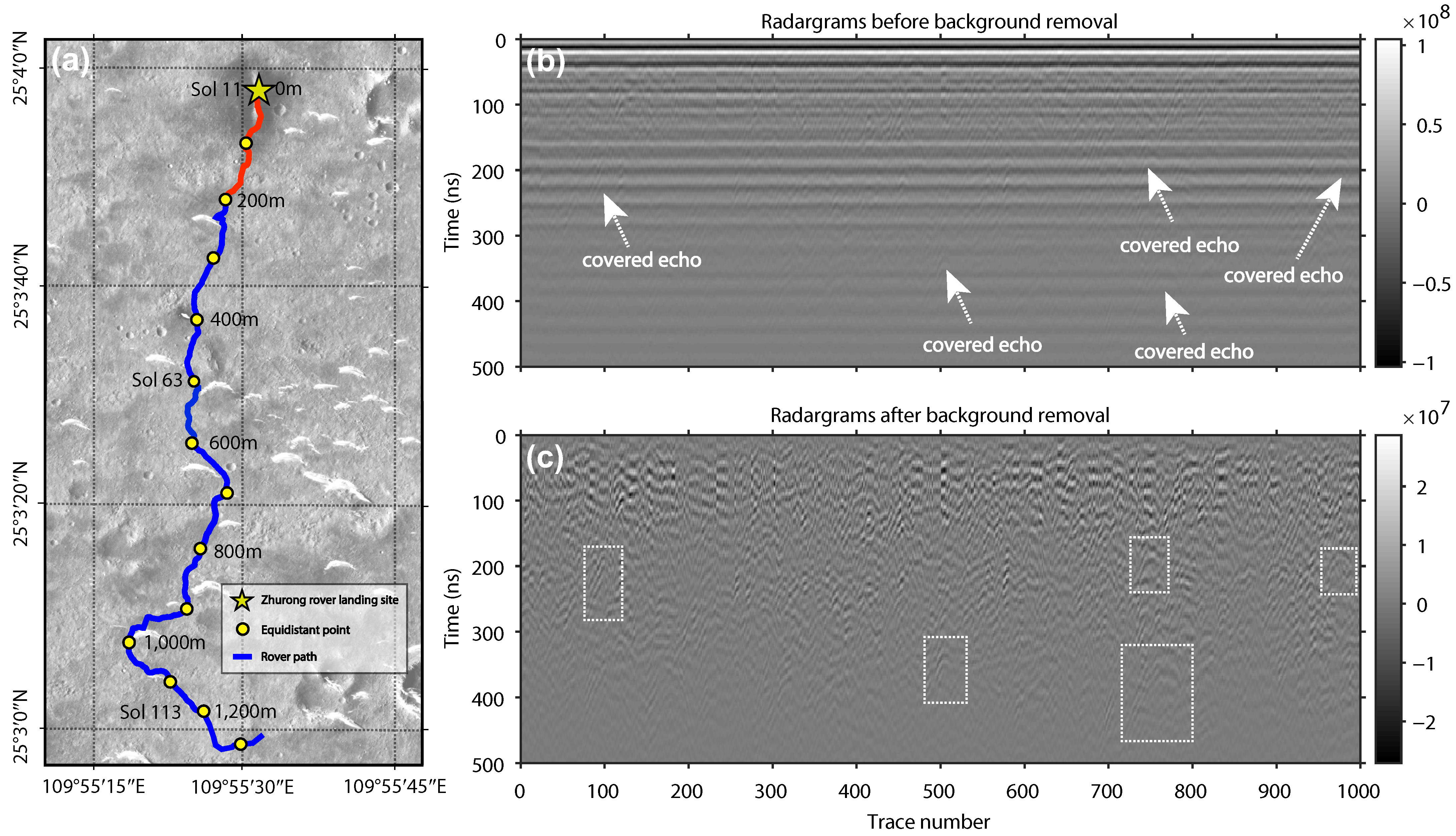




| Layers | Depth (m) | Quantity | Radius (m) | Permittivity | Conductivity (S/m) |
|---|---|---|---|---|---|
| 1st layer | 0∼8 | 80 | 0.25∼1.00 | 1.75∼10 | (0.37∼3.35) |
| 2nd layer | 8∼30 | 400 | 0.25∼2.00 | 1.75∼13 | (0.37∼3.73) |
| 3rd layer | 30∼70 | 260 | 0.25∼2.25 | 1.75∼13 | (0.37∼3.73) |
Disclaimer/Publisher’s Note: The statements, opinions and data contained in all publications are solely those of the individual author(s) and contributor(s) and not of MDPI and/or the editor(s). MDPI and/or the editor(s) disclaim responsibility for any injury to people or property resulting from any ideas, methods, instructions or products referred to in the content. |
© 2023 by the authors. Licensee MDPI, Basel, Switzerland. This article is an open access article distributed under the terms and conditions of the Creative Commons Attribution (CC BY) license (https://creativecommons.org/licenses/by/4.0/).
Share and Cite
Zhong, S.; Wang, Y.; Zheng, Y.; Chen, L. Mars Rover Penetrating Radar Modeling and Interpretation Considering Linear Frequency Modulation Source and Tilted Antenna. Remote Sens. 2023, 15, 3423. https://doi.org/10.3390/rs15133423
Zhong S, Wang Y, Zheng Y, Chen L. Mars Rover Penetrating Radar Modeling and Interpretation Considering Linear Frequency Modulation Source and Tilted Antenna. Remote Sensing. 2023; 15(13):3423. https://doi.org/10.3390/rs15133423
Chicago/Turabian StyleZhong, Shichao, Yibo Wang, Yikang Zheng, and Ling Chen. 2023. "Mars Rover Penetrating Radar Modeling and Interpretation Considering Linear Frequency Modulation Source and Tilted Antenna" Remote Sensing 15, no. 13: 3423. https://doi.org/10.3390/rs15133423






